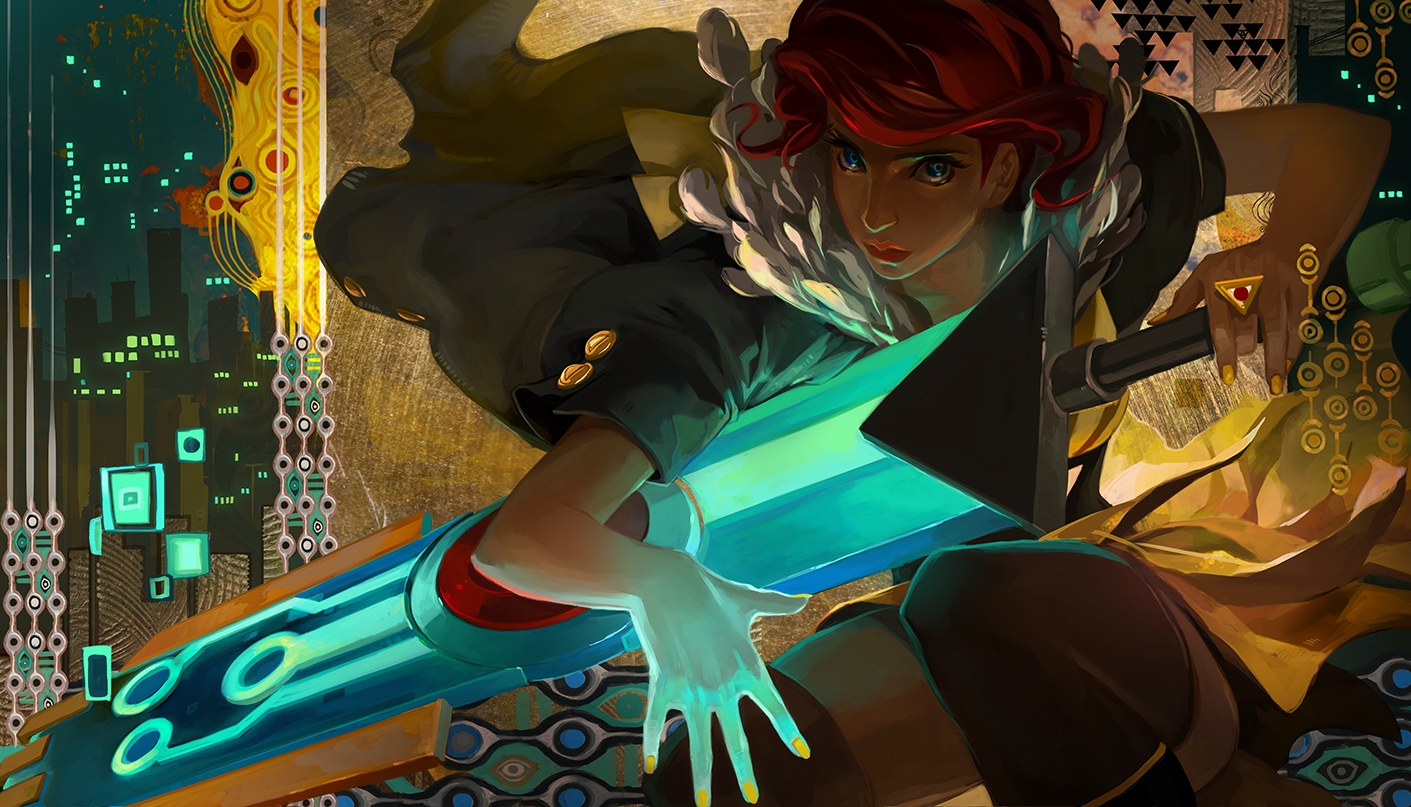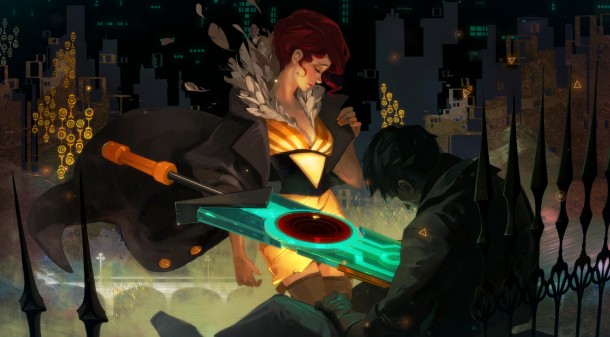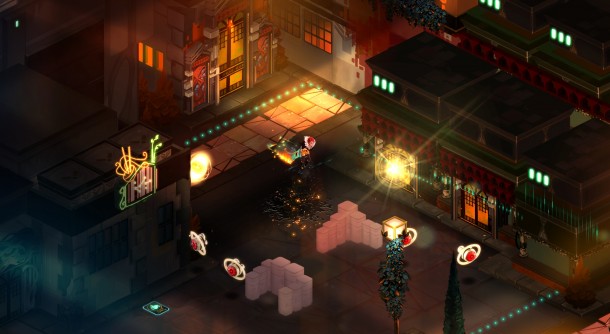For a game with a silent protagonist, the world of Transistor is saturated with its leading lady’s voice. The songstress Red’s lyrics swell from the game’s soundtrack. When players take advantage of the gameplay’s Turn feature, Red hums to herself as players plot out her plan of attack. Even Transistor’s reveal trailer from last March spotlights the vocal talents of Supergiant Games’ latest protagonist (voiced by the inimitable Ashley Barrett).
Transistor may give its heroine many ways to make her voice heard, but it leaves me speechless.
Supergiant Games’ latest title revolves around Red, a former star who is relentlessly pursued by assailants called the Process. After a failed assassination attempt, she manages to steal a weapon known as the Transistor from her attackers. A dear acquaintance of hers (whose exact identity is unknown) is killed during the scuffle, but his voice and mind live on in the weapon, allowing him to serve as the game’s de facto narrator. Together, they resolve to hunt down the Camerata—the controllers of the Process—and uncover the group’s sinister plan.
The interaction between these two—the voiceless player character and bodiless voice—make Transistor’s story simply enthralling. Red is a firebrand whose silent determination and sheer pique work to empower both her and the player. Her status as a target positions her as one of the more influential members of Cloudbank City, and her defiant decision to fight rather than flee make this entirely believable. The Transistor is a little more mysterious. His commentary makes it clear that he cares for Red, but the nature of their relationship is unclear, at first. It’s a dynamic that’s meant to be explored and expanded through the story itself. As with Bastion, Logan Cunningham lends his vocal talents to the voice of the Transistor. His commentary about the player’s actions makes it impossible to not feel strong as Red.
Transistor quickly reveals itself to be a worthy successor to the explosively popular Bastion—Supergiant’s premiere title. It borrows with confidence from its predecessor, taking and refining features like Bastion’s isometric gameplay and interactive narration. Its new features—and protagonist—help Supergiant’s sophomore effort feel like an entirely new experience with the perfect amount of sentimental nods to Bastion.
The “Functions”—or abilities—are among Transistor’s most addicting features. Functions are largely acquired by interacting with the remnants of former Cloudbank citizens. Inspecting these abilities reveals character profiles which provide insight into the Camerata’s foul schemes. The most important information requires additional “decryption” to access, and this may be obtained by equipping the Functions in active, upgrade, and passive slots. This means that each Function may be used in one of three ways: as an active attack, an upgrade to another attack, or as a passive skill. Attacks become mapped to specific action buttons, while the Upgrade Functions enrich those that they’re paired with. Passive skills give Red an extra edge in combat by serving as buffs instead of abilities. I found myself combining the explosive, grenade-like attack “Spark” with an upgrade Function called “Switch” that caused affected enemies to temporarily become allies. I would have been tempted to stick with such a potent skill combination if not for the Decryption feature, and so I found myself trying out endlessly new and appealing combinations of Functions just to learn more about Cloudbank and its most prolific residents.
Combat is fast-paced and exciting. Players have the option of hacking away at the enemy Process in real-time or exploiting the game’s “Turn” feature, which freezes combat and allows players to plot out attacks in advance. An action bar at the top of the screen determines the number of attacks that Red can dole out. Once players are satisfied with their decisions, they can end the turn and watch Red execute their attacks in a deadly flurry of activity. If a mistake is made during planning, it can literally be fixed with the push of a button, removing the last selected attack from the action bar. Overall, the Turn function is a stylish and cool way of adding a strategic approach to the old click-until-it’s-dead formula (though that is still a viable option, too).
Each enemy type has unique skills that require an equally unique plan of approach. I found that some enemies were less susceptible to frontal assaults, forcing me to navigate behind them during a turn to take advantage of the game’s back-stab feature (which deals out bonus damage). Other enemies, like the aptly named “Cheerleaders,” provided support for the other Process in the form of unassailable force fields or health regeneration. The game generates these enemies in consistently new and challenging combinations. Successful enemy encounters grants experience and increases Red’s User Level. As Red becomes stronger, the enemies do, too. Stronger enemies feature version numbers (or levels) by their name to indicate just how big and bad they are, and the game also provides commentary on the new traits that come with each version update. The Process might get a more penetrative beam or acquire increased defenses with an update. Adaptation and observation are key when facing the Process.
For those intrepid gamers seeking more challenging gameplay, access points throughout the game allow them to activate Process Limiters, which give the Process an additional edge in combat. The earliest of these Limiters causes the Process to spawn shielded Cells upon being defeated, which makes it far more possible for these Cells to regenerate enemies if players are not prudent with their crowd control. Each active Limiter gives players bonus experience after each conflict, allowing them to unlock additional Functions and Limiters at a heightened rate.
These features—and the customization that they offer—make for addictive gameplay that caters to a variety of play styles and skills. As compelling as the story is, it’s difficult not to get equally invested in the cyclical pattern of defeating enemies, unlocking new Functions and Limiters, and experimenting with the new combinations that they offer. To this purpose, Transistor features a game mode called Recursion that unlocks upon completing the game. It allows players to retain their User Level and Functions upon replay, giving them the opportunity to unlock all of the Function’s decryptions and experiment with the staggering amount of combined abilities in-game. Unlockable mini-levels in the core game itself act as proving grounds (to borrow Bastion’s term for such levels), where players can experiment with the Functions and test their gaming mettle. The gameplay options for Transistor are as varied as the in-game abilities themselves, resulting in hours upon hours of playable (and enjoyable) content.
Of course, Transistor’s sounds and aesthetics are as much as a draw as its well-rounded gameplay. Darren Korb, who scored Bastion, once again raises the bar for videogame music. Because of its science-fiction setting, its sounds are distinct from the acoustic frontier trip hop of Bastion, resulting in a genre that Darren referred to in a prior interview as “Electronic Post-Rock Old World.” Though Transistor’s OST holds its own just fine as music for casual listening, I urge others to experience the music in game before listening to it independently. The soundtrack is an artful representation of Red and the other occupants of Cloudbank City, and so it has a profound effect on the game’s atmosphere that may be diminished by hearing the soundtrack out of context first.
From the blinding lights of Red’s stage to the more familiar and urban alleyways, Transistor is consistently easy on the eyes and wonderful to behold. There’s a lot of cleverness in its design. The city, at times, feels unnervingly familiar, with its poster advertisements and quippish news broadcasts. The differences are in its details. Glowing white squares on a pathway flutter away as Red approaches, revealing themselves to be strange birds. Kiosks quiz the city’s citizens on their weather preferences, implying that weather is a generated phenomenon rather than a natural one. It’s an environment that is both familiar and alien, shining and dark. Even though Red’s progress through the city was linear (as is common with isometric games), I still felt compelled to explore Cloudbank’s every corner to uncover its secrets. The game has a visual style and character that is uniquely its own.
Equal parts work of art and videogame, Transistor may very well be the first must-play title of 2014. The degree of customization in its combat and ability features is simply staggering, and its gameplay is deeply enmeshed in a world that is both unique and beautiful to behold. Considering that Supergiant Games is a team of ten people, it seems fitting that Transistor’s story deals with how the voices of few can affect the lives of many. I suspect that Transistor’s impact will be palpable in future indie and triple-A games alike. It looks like Supergiant Games, the small studio with big talent, is all set for another jaunt in the spotlight.
This review is based on a Steam code sent to SideQuesting by the publisher.






No Comments